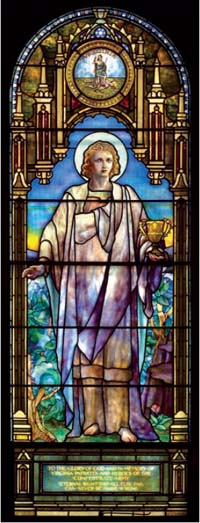 Opalescent Glass
Opalescent Glass
Image: Virginia Window Featuring Saint John, ca. 1904, by Louis Comfort Tiffany (American, 1848–1933), for Tiffany Studios, New York, one of the Compass Windows of Old Blandford Church in Petersburg, Virginia
The main ingredient of Tiffany windows is opalescent glass, which was invented by Tiffany’s rival and one-time friend, John LaFarge (1835 – 1910). In an 1879 patent application, LaFarge described his process: This opal glass will be more or less opaque or milky in parts. . . . by checking or graduating the amount of light in this way, [I] gain effects as to depth, softness, and modulation of color. . . . These opalescent and iridescent effects may be enhanced by the greater or less smoothness of one or both of the surfaces of the opalescent glass, and by its thickness, and the glass may be waved, corrugated, or roughened in the molds, or be hammered or rolled or stamped or treated to accord with the design. . . . In some instances I . . . back colored glass of ordinary construction with independent pieces of opal glass, one or more layers of either being used, according to the desired effect. Tiffany persuaded LaFarge to waive the rights to his patent and within a short time had he applied for and received several glass patents of his own.
Limited Use of Painted Glass
Louis Comfort Tiffany believed that the more paint was fired onto the glass, the less light would come through it. Traditionally, such details as the folds of garments had been painted on. Tiffany’s answer was to replace such painting with drapery glass. Generally speaking, only physical features such as faces, hands, and feet are painted on Tiffany’s figures.
Drapery Glass
Tiffany created glass that simulated the folds and flow of garments worn by figures in his windows. After pouring molten glass onto an iron table, his glassmakers would use tongs and even pliers to manipulate the glass into actual folds. Drapery glass also found its way into petals of flowers in the windows.
Confetti Glass
Also called fractured glass, confetti glass was created by modifying an ancient practice of imbedding bits of colored glass into clear glass. Tiffany’s method was to scatter chips and fragments of glass, resembling confetti, onto the iron table. Molten glass would be poured over it and rolled flat, pressing the chips into the underside of the glass. Confetti glass was often used as background in landscape and floral windows.
Lead
Traditionally, lead was used in windows to hold the glass in place rather than as part of the design. Lead lines might zigzag through a window, cutting body parts or outfits in segments. In Tiffany designs, the lead lines conform to the seams of fabrics or the shapes of arms. Even individual leaves or petals are outlined in lead instead of outlining a whole bouquet and painting the flowers.
Plated Glass
Tiffany also used multiple layers of glass, or plating, in many of his designs, sometimes on the inside of the window, sometimes on the outside. This achieved effects of depth. Sometimes as many as four or five sheets of glass were used. As the years wore on, however, these layers created a problem. Since lead is a very soft metal, the increased weight sometimes caused premature bowing of a window, and water, dirt, or other particles worked their way between the layers. Tiffany continued to refine his designs to accommodate this structural problem.